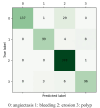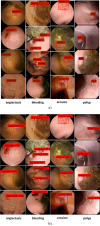Cascade-EC Network: Recognition of Gastrointestinal Multiple Lesions Based on EfficientNet and CA_stm_Retinanet
- PMID: 38587768
- PMCID: PMC11522239
- DOI: 10.1007/s10278-024-01096-9
Cascade-EC Network: Recognition of Gastrointestinal Multiple Lesions Based on EfficientNet and CA_stm_Retinanet
Abstract
Capsule endoscopy (CE) is non-invasive and painless during gastrointestinal examination. However, capsule endoscopy can increase the workload of image reviewing for clinicians, making it prone to missed and misdiagnosed diagnoses. Current researches primarily concentrated on binary classifiers, multiple classifiers targeting fewer than four abnormality types and detectors within a specific segment of the digestive tract, and segmenters for a single type of anomaly. Due to intra-class variations, the task of creating a unified scheme for detecting multiple gastrointestinal diseases is particularly challenging. A cascade neural network designed in this study, Cascade-EC, can automatically identify and localize four types of gastrointestinal lesions in CE images: angiectasis, bleeding, erosion, and polyp. Cascade-EC consists of EfficientNet for image classification and CA_stm_Retinanet for lesion detection and location. As the first layer of Cascade-EC, the EfficientNet network classifies CE images. CA_stm_Retinanet, as the second layer, performs the target detection and location task on the classified image. CA_stm_Retinanet adopts the general architecture of Retinanet. Its feature extraction module is the CA_stm_Backbone from the stack of CA_stm Block. CA_stm Block adopts the split-transform-merge strategy and introduces the coordinate attention. The dataset in this study is from Shanghai East Hospital, collected by PillCam SB3 and AnKon capsule endoscopes, which contains a total of 7936 images of 317 patients from the years 2017 to 2021. In the testing set, the average precision of Cascade-EC in the multi-lesions classification task was 94.55%, the average recall was 90.60%, and the average F1 score was 92.26%. The mean mAP@ 0.5 of Cascade-EC for detecting the four types of diseases is 85.88%. The experimental results show that compared with a single target detection network, Cascade-EC has better performance and can effectively assist clinicians to classify and detect multiple lesions in CE images.
Keywords: Capsule endoscopy; Cascade-EC; Lesion detection and location; Split-transform-merge strategy.
© 2024. The Author(s) under exclusive licence to Society for Imaging Informatics in Medicine.
Conflict of interest statement
The authors declare no competing interests.
Figures






References
-
- Fitzmaurice C, Allen C, Abbasi N et al: Global, Regional, and National Cancer Incidence, Mortality, Years of Life Lost, Years Lived With Disability, and Disability-Adjusted Life-years for 32 Cancer Groups, 1990 to 2015: A Systematic Analysis for the Global Burden of Disease Study. JAMA Oncol, 3: 524-48, 2017. - PMC - PubMed
-
- Xiao Z, Feng L N.: A Study on Wireless Capsule Endoscopy for Small Intestinal Lesions Detection Based on Deep Learning Target Detection. IEEE Access, 8: 159017-26, 2020.
-
- Samir J, Ayan S, Aparajita O, et al: Detection of abnormality in wireless capsule endoscopy images using fractal features. Comput Biol Med, 127: 104094, 2020. - PubMed
-
- Samir J, Ayan S, Aparajita O: A Convolutional Neural Network with Meta-feature Learning for Wireless Capsule Endoscopy Image Classification. J Med Biol Eng, 43: 475-494, 2023.
MeSH terms
Grants and funding
LinkOut - more resources
Full Text Sources
Research Materials
